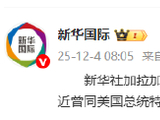China at Osaka World Expo; Kenyatta's Visit to China; Sino-Indian Relations
The Dazzling Display of China's Traditional Wisdom at the Osaka World Expo
The recent Osaka World Expo showcased China’s immense efforts in promoting traditional ecological wisdom and green development ideas. Held in a city known for its blend of modernity and tradition, the China Pavilion captured global attention with its innovative presentation—a fusion of ancient Chinese cultural idioms engraved on its exterior and pioneering technology within. One standout feature is the interactive large multimedia displays that bring to life traditional Chinese concepts like the '24 Solar Terms,' vividly illustrating the harmonious relationship between nature and humanity. The exposition, heralded as a 'beautiful future society,' resonates with both historical reverence and forward-thinking ambition.
The intention behind the People's Daily coverage appears to bolster China's image as a global leader in ecological and technological advancements, a narrative China seeks to propagate not only to foster international partnerships but also to strengthen cultural diplomacy. Remarkably, the exposition aims for deeper Japan-China regional collaboration, as highlighted by Japanese dignitaries' expressions of awe and the prospects for continued bilateral engagement.
Kenyatta's Visit: Strengthening Ties Under the Belt and Road Initiative
Elsewhere, Kenyatta's visit to China, underscored by the 'One Belt, One Road' initiative, underlines the deepening Sino-Kenyan ties with infrastructure and energy at the forefront. President Kenyatta's itinerary focused on extending the standard gauge railway system—a key infrastructure project—and emphasizing renewable energy cooperation, an area where China excels in terms of technological prowess. People’s Daily interviews highlight Kenya's keenness to align more with China's developmental blueprint, notably in industrial and renewable energy sectors.
This diplomatic gesture also emphasizes China's strategic engagement in Africa, mapping out a cooperative future that leverages China's capabilities in solar technologies and Kenya's rich renewable potential. President Kenyatta's accolades for China's poverty alleviation successes suggest a broader continental admiration and a model for African nations grappling with similar challenges.
Warning Shots: China's Trade Dispute Tensions with the U.S.
In geopolitical tremors, the New York Times reports on China's warning against international alliances forming against Chinese trade practices. This confrontation hints at a growing weariness in Beijing over U.S. influence rallying for stricter trade scrutiny. The New York Times' exposition reflects a critical perspective on how these tensions might escalate economic divides or lead to retaliatory policies that could hamper global trade dynamics.
The emphasis here is on a narrative contrasting with China's media outlets: while Chinese reports would typically spotlight cooperative traits and economic benefits, this report points towards apprehension in international trade circles about China's rising economic assertiveness. The ramifications can ripple across global markets, challenging nations to balance economic interests with geopolitical alignments.
China-India Dialogues: Strategic Engagement for Regional Stability
China’s inaugural 2+2 Dialogue with India marks a significant step in nurturing Sino-Indian relations, pointing towards deeper defense and diplomatic alignments. This meeting symbolizes a substantial commitment to navigate shared concerns and ambitions, with both nations as pivotal players in Asia's geopolitical tapestry. The coverage, prominently featured in the People's Daily, underscores mutual respect and cooperative frameworks intended to transcend regional tensions.
The dialogue highlights the importance of mechanisms that facilitate open communication and defuse potential crises. India's Foreign Minister's positive remarks on deepening ties underline a mutual desire for stability and economic prosperity within the region. These developments represent a strategic interplay aimed at fortifying regional security and addressing broader global challenges together.
Celebrations and Commemorations: Reinforcing Historical Ties
Apart from diplomatic discussions, celebrations surrounding the 75th anniversary of Sino-Indian relations further cement historical ties between the two nations. Such ceremonies function as platforms to rejuvenate bilateral enthusiasm for joint ventures and shared cultural heritage. These events serve to remind both populations and the international community of peaceful coexistence and shared progress as fundamental pivots for the future.
As both nations reflect on years of diplomatic milestones, there remains a visible optimism for perennial collaboration. The reiteration of foundational principles like mutual benefit and equality signals the intention to preserve communal goodwill—a central message propagated by state media to bolster the perception of unity amid evolving geopolitical landscapes.
Medical AI: A Helping Hand, Not a Replacement
Xinhua News covers an intriguing competition where AI models went head-to-head with human doctors in diagnosing neurological diseases. AI models like 39AI, Doubao, and DeepSeek rapidly analyzed cases, often outperforming in diagnostics speed and breadth. However, they fell short of delivering the nuanced, personalized care plans that experienced doctors provide, especially in complex cases requiring surgery.
The diverse scoring in this event illuminates the evolving nature of AI in healthcare. Quick and broad analyses offered by AI can be invaluable in standard cases or when human resources are scarce. Nonetheless, the irreplaceable human touch in medicine—empathy, instinct, and personalized interactions—underscores doctors' roles. Globally, this suggests a hybrid future where AI assists rather than supplants medical professionals, particularly in regions struggling with doctor shortages.



